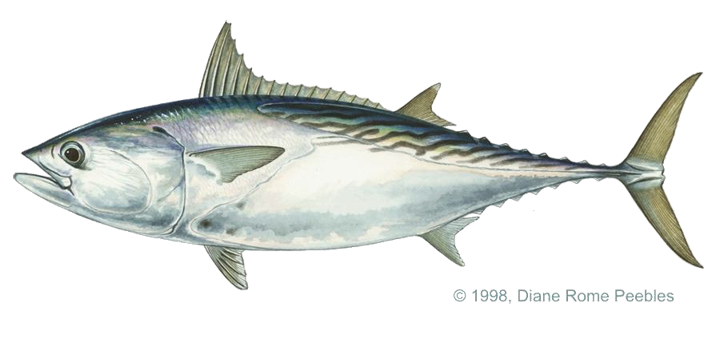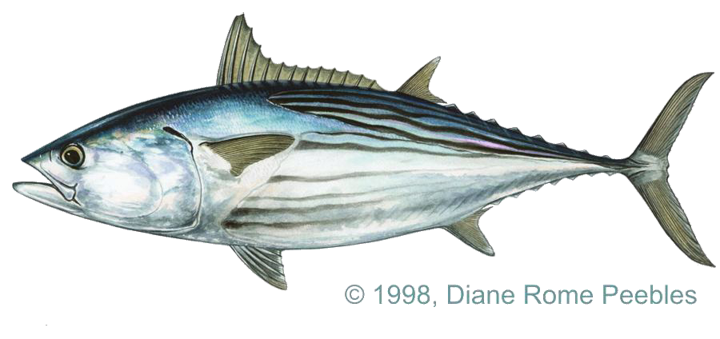Game Fish Identification Reference Guides
Kawakawa
(Euthynnus affinis)
(Euthynnus affinis)

(Cantor, 1849); SCOMBRIDAE FAMILY; also called wavyback skipjack, eastern little tuna, mackerel, tuna, Pacific little tunny, false albacore.
Widespread in tropical and temperate waters of the Indo Pacific from the Red Sea and South Africa east to Indonesia and Australia, and from Japan and the Philippines through Oceania to the Hawaiian Islands. It is accidental in the eastern Pacific where it is replaced by the closely related black skipjack, Euthynnus lineatus. This pelagic and migratory species stays fairly close to land. It may be found near reefs and in estuaries as well as in open waters.
The dorsal fin has 14 16 spines and the second dorsal fin, 12 13 rays. The anal fin has 12 14 rays. There are no scales on the body, except on the corselet and lateral line. There are 29 34 gill rakers on the first arch, as compared to 53 63 in the skipjack tuna, Katsuwonnus pelamis, and 32 41 in the black skipjack, E. lineatus. On the back, beginning near the midpoint of the dorsal fin, there are a number of oblique, wavy lines over a turquoise background. These squiggly lines run from the lateral line back towards the dorsal fins. Some live specimens may display dark, prominent longitudinal stripes on the venter. These stripes tend to disappear quickly once the fish is removed from the water, leaving only a number of dark spots showing between the pectoral fins and the ventral fins.
More than half of the food ingested by the kawakawa consists of crustaceans, though squid and pelagic fish also form a large part of its diet. Fishing methods include trolling lures or whole or cut baits, live bait fishing, casting, and spin fishing.
The flesh is dark red. In some places it is highly valued as food, though there is no specific commercial market for it. In Hawaii it is often served as sashimi
Widespread in tropical and temperate waters of the Indo Pacific from the Red Sea and South Africa east to Indonesia and Australia, and from Japan and the Philippines through Oceania to the Hawaiian Islands. It is accidental in the eastern Pacific where it is replaced by the closely related black skipjack, Euthynnus lineatus. This pelagic and migratory species stays fairly close to land. It may be found near reefs and in estuaries as well as in open waters.
The dorsal fin has 14 16 spines and the second dorsal fin, 12 13 rays. The anal fin has 12 14 rays. There are no scales on the body, except on the corselet and lateral line. There are 29 34 gill rakers on the first arch, as compared to 53 63 in the skipjack tuna, Katsuwonnus pelamis, and 32 41 in the black skipjack, E. lineatus. On the back, beginning near the midpoint of the dorsal fin, there are a number of oblique, wavy lines over a turquoise background. These squiggly lines run from the lateral line back towards the dorsal fins. Some live specimens may display dark, prominent longitudinal stripes on the venter. These stripes tend to disappear quickly once the fish is removed from the water, leaving only a number of dark spots showing between the pectoral fins and the ventral fins.
More than half of the food ingested by the kawakawa consists of crustaceans, though squid and pelagic fish also form a large part of its diet. Fishing methods include trolling lures or whole or cut baits, live bait fishing, casting, and spin fishing.
The flesh is dark red. In some places it is highly valued as food, though there is no specific commercial market for it. In Hawaii it is often served as sashimi














